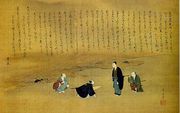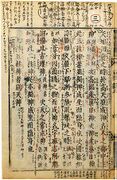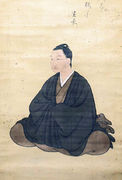Glossar:Motoorinorinaga: Unterschied zwischen den Versionen
Zur Navigation springen
Zur Suche springen
K (Textersetzung - „\{\{\{2\|(.*)\}\}\}“ durch „$1“) |
K (Textersetzung - „\|(\s*)“ durch „$1| “) |
||
| Zeile 1: | Zeile 1: | ||
| − | {{Glossar| | + | {{Glossar| |
| − | kanji=本居宣長| | + | kanji=本居宣長| |
| − | romaji=Motoori Norinaga| | + | romaji=Motoori Norinaga| |
| − | text= Shinto-Gelehrter der „nationalen Schule“ (Kokugaku), 1730—1801 | | + | text= Shinto-Gelehrter der „nationalen Schule“ (Kokugaku), 1730—1801 | |
| − | stichwort ={{{1|}}}| | + | stichwort ={{{1| }}}| |
| − | link=Geschichte:Kokugaku| | + | link=Geschichte:Kokugaku| |
tags= person | tags= person | ||
}} | }} | ||
Version vom 22. September 2014, 22:24 Uhr
Motoori Norinaga 本居宣長 (jap.)
Shinto-Gelehrter der „nationalen Schule“ (Kokugaku), 1730—1801
Der Begriff „Motoori Norinaga“ wird in diesem Handbuch auf folgenden Seiten erwähnt:
- Shintō: Versuch einer Begriffsbestimmung (Kapitel „Grundbegriffe“)
- Japans klassische Mythentexte (Kapitel „Mythen“)
- Jenseitsvorstellungen (Kapitel „Mythen“)
- Kokugaku: Back to the roots (Kapitel „Geschichte“)
- Shintō im Mittelalter (Kapitel „Geschichte“)
- Aufbruch in eine neue Ära: Bakumatsu-Zeit, 1853–1867 (Kapitel „Geschichte“)
- Unterhändler des Imaginären: Regenmachen im vormodernen Japan (Kapitel „Essays“)
Bilder


